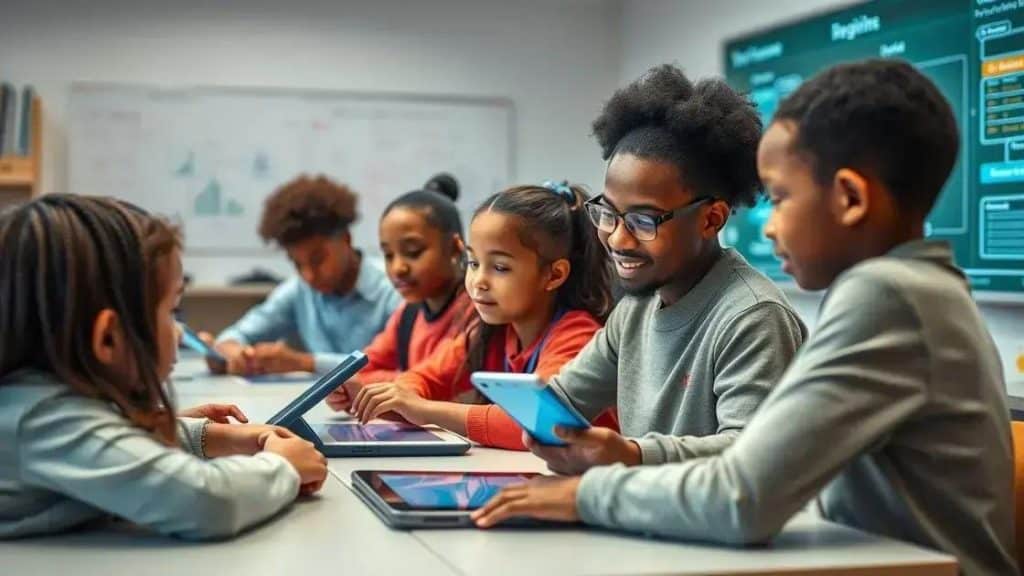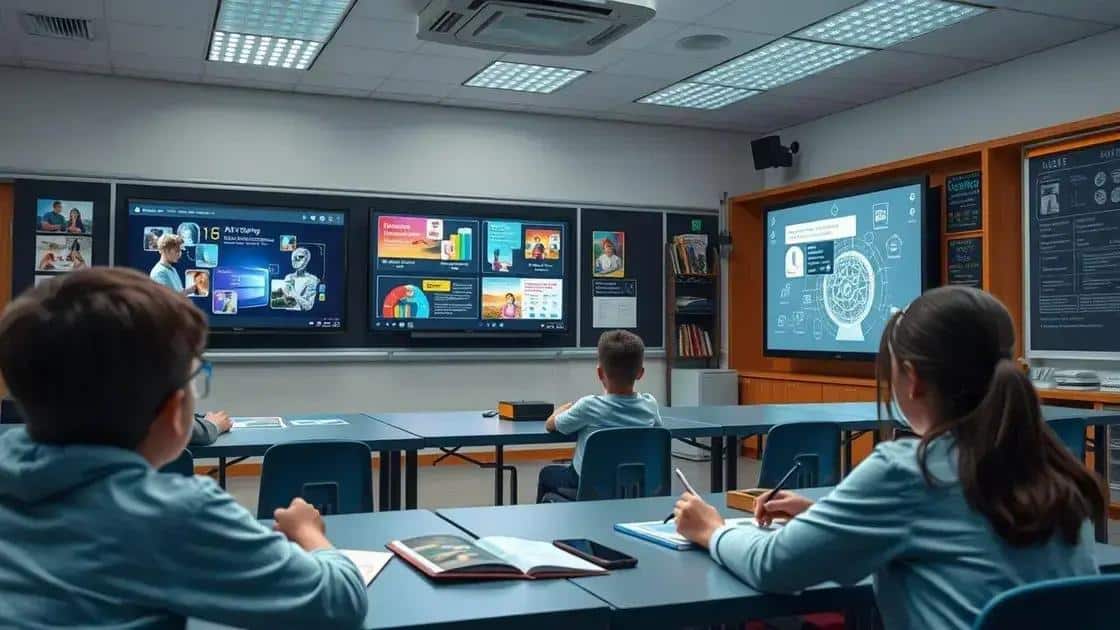Insights on ai in classrooms: enhancing learning experiences

AI in classrooms enhances learning by personalizing education, creating immersive experiences, and providing immediate feedback, while also presenting challenges like cost and the need for teacher training.
Insights on ai in classrooms show a remarkable shift in how students learn and engage. Imagine a classroom where technology adapts to each student’s needs—it’s happening now! Explore how AI is reshaping education.
Benefits of ai in classroom settings
Understanding the benefits of AI in classroom settings is crucial for educators looking to enhance their teaching methods. These tools can help personalize education, making learning more effective and engaging for students.
One of the significant advantages of AI is its ability to tailor learning experiences to individual students. As each learner has unique strengths and weaknesses, AI algorithms can analyze performance data and adapt content accordingly.
Improved Engagement
AI not only personalizes learning but also keeps students engaged. By utilizing interactive interfaces and gamified elements, AI tools attract attention and make learning fun.
- Interactive learning platforms
- Real-time feedback on performance
- Adaptive learning paths
Furthermore, AI streamlines administrative tasks, allowing teachers more time to focus on instruction. For instance, grading can be automated, reducing workload significantly. Imagine a classroom where educators spend less time on paperwork and more on inspiring students!
Enhanced Data Analysis
AI excels at processing vast amounts of data swiftly. This capability means teachers can access insights about class performance, enabling them to make informed decisions on curricula and teaching strategies.
- Identifying trends in student performance
- Personalized reports for parents
- Improving class participation techniques
Overall, the integration of AI into classrooms brings substantial benefits. From improved engagement to efficient administrative processes, these technologies are paving the way for a more effective educational landscape.
How ai personalizes learning experiences

AI plays a vital role in personalizing learning experiences for students, addressing their unique needs and preferences. By utilizing advanced algorithms, AI systems can analyze data to understand how each student learns best.
When implemented in classrooms, AI technology can create tailored study programs that adapt in real-time. For instance, if a student struggles with a particular topic, the AI can provide additional resources on that subject, making learning more effective.
Adaptive Learning Pathways
One of the most impressive features of AI is its ability to establish adaptive learning pathways. This means that as students progress, the system changes the content to ensure ongoing learning without overwhelming them.
- Dynamic assessments to gauge understanding
- Customized learning materials based on student progress
- Interactivity to maintain student engagement
Another significant aspect is the immediate feedback provided by AI tools. Rather than waiting for a teacher to grade an assignment, students receive insights right away. This kind of feedback helps them understand their mistakes immediately, enhancing their learning curve.
Inclusive Learning Environments
AI facilitates inclusivity in education by catering to different learning styles. Whether a student is a visual learner or prefers auditory methods, AI can adjust the materials accordingly.
- Visual aids for visual learners
- Audio explanations for auditory learners
- Kinesthetic learning opportunities for hands-on experiences
With AI, every student can feel valued and supported in their educational journey. This tailored approach helps foster a love for learning and encourages students to explore new concepts at their own pace.
Challenges of implementing ai in education
Implementing AI in education comes with a range of challenges that schools and educators must navigate. While the benefits are numerous, the obstacles can impact how effectively this technology is used.
One significant challenge is the cost of technology. Many institutions may struggle to afford the initial investment required for AI tools and infrastructure. Budget constraints can limit access to these advanced resources, making it difficult to implement AI solutions.
Training and Support
Another hurdle is the need for proper training and support for teachers. Integrating AI in the classroom requires educators to become familiar with new tools and technologies. Without adequate training, teachers may feel overwhelmed or unsure of how to utilize these resources effectively.
- Professional development sessions
- Ongoing support from tech specialists
- User-friendly interfaces
Moreover, data privacy and security concerns present significant issues. Educators must ensure that student data is handled safely and following legal regulations. The fear of data breaches can hinder the willingness of schools to adopt AI solutions.
Resistance to Change
Resistance to change can also be a barrier when implementing AI in education. Some educators may prefer traditional teaching methods, fearing that technology will diminish personal interactions with students. Addressing these fears is vital for successful integration.
- Showcasing successful AI implementations
- Encouraging collaboration between tech-savvy and traditional educators
- Highlighting AI’s role in enhancing teaching
Overall, while the challenges of implementing AI in education are significant, they can be addressed through careful planning and support. By tackling these issues, schools can pave the way for a more innovative and effective educational experience.
Future trends of ai in classrooms

The future trends of AI in classrooms promise exciting developments that can reshape education as we know it. As technology continues to evolve, educators can expect even more innovative solutions to enhance learning.
One major trend is the use of AI-driven analytics to assess student performance. These analytics can provide teachers with real-time insights into how well students are grasping concepts. Imagine understanding which areas need improvement instantly, helping to tailor instruction to individual needs.
Enhanced Learning Environments
Additionally, AI will contribute to creating more immersive learning environments. With virtual and augmented reality technologies, students may soon explore historical events or complex scientific concepts in a virtual space that feels real. This capability can increase engagement and deepen understanding.
- Simulations for hands-on learning
- Virtual field trips to global locations
- Interactive labs for science experiments
Moreover, chatbots are expected to play a larger role in education. These AI-powered assistants can provide students with 24/7 support for homework questions and general queries, ensuring they have access to help whenever they need it.
Personalization Beyond Basics
As AI matures, personalization will extend beyond basic adjustments in learning paths. Future systems may predict learning outcomes and suggest new content and approaches before students even realize they need them.
- Customized learning resources
- Adaptive assessments that evolve with students
- Integration of social learning experiences
With continued advancements in technology, it’s essential for educators to remain informed and adaptable. By embracing these future trends, schools can prepare students for a rapidly changing world.
FAQ – Frequently Asked Questions about AI in Classrooms
What are the main benefits of using AI in education?
AI can personalize learning, provide immediate feedback, and help teachers understand student performance more effectively.
How can AI create immersive learning experiences?
Through technologies like virtual and augmented reality, AI can enable students to explore subjects in interactive and engaging environments.
What challenges do schools face when implementing AI?
Challenges include the cost of technology, the need for teacher training, and concerns about data privacy.
Will AI change the role of teachers in the classroom?
Yes, AI can assist teachers with administrative tasks, allowing them to focus more on interacting with and supporting their students.





